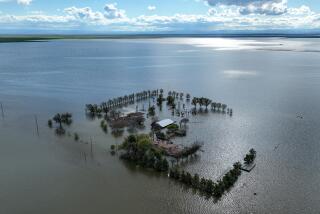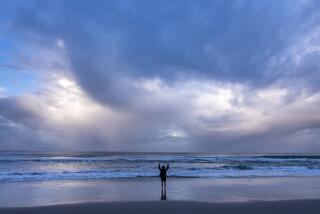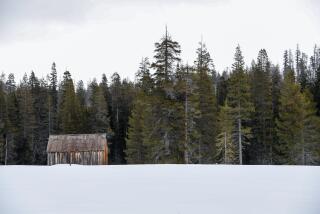California’s ‘big one’ might be a megastorm
California’s “big one” may not be an earthquake at all, but a devastating megastorm that would inundate the Central Valley, trigger widespread landslides and cause flood damage to 1 in 4 homes in the state.
The prospect of such a storm was raised this month by scientists predicting the consequences of an “atmospheric river” of moisture from the tropical Pacific hitting California with up to 10 feet of rain and hurricane-force winds over several weeks.
A team of more than 100 scientists, engineers and emergency planners used flood mapping, climate change projections and geologic flood history to simulate a hypothetical storm so intense that it occurs only every 100 to 200 years. They presented their findings in Sacramento during a conference sponsored by the U.S. Geological Survey, the Federal Emergency Management Agency and the California Emergency Management Agency.
The study isn’t meant to be a forecast that such a fierce storm is imminent, but rather a push by scientists to publicize the risk of a catastrophe that they say is unfamiliar to most Californians.
In the scenario — powerful back-to-back storms — floods could require about 1 1/2 million people to evacuate and cause more than $300 billion in property damage. The economic loss would be four times that of a very large earthquake.
The simulation was based on the most severe storm event on record in California, a 45-day series of storms that started in December 1861 and, according to the Geological Survey, caused such extensive flooding that the Sacramento Valley was turned into “an inland sea, forcing the state Capitol to be moved temporarily from Sacramento to San Francisco, and requiring Gov. Leland Stanford to take a rowboat to his inauguration.”
Geologists studying prehistoric flood deposits found evidence of even larger storms that occurred about every 300 years. Scientists project storms of that magnitude to become more frequent and powerful as a result of global warming.
Scientists said the study highlights the need to prepare for the large-scale devastation of powerful winter storms, which have received far less attention than the threat of earthquakes. Unlike a quake, which radiates from a single location, a megastorm would cause destruction spanning the entire state.
“We need to recognize that flooding here in California is as much of a risk as an earthquake,” said Lucy Jones, chief scientist for the Geological Survey’s Multi-Hazards Project. “These storms are like hurricanes in the amount of rain that they produce.”
The exact effects of a colossal storm would depend on weather patterns that cannot be predicted until about a week before they strike. But the study identified some of the most vulnerable areas.
Los Angeles County, Orange County, San Diego and the San Francisco Bay Area would be especially susceptible to the floodwaters of overflowing rivers. A 300-mile-long expanse of the Central Valley would be underwater, with substantial losses of crops, livestock and urban structures. The rains would overwhelm much of the state’s flood protection system, especially in the Sacramento-San Joaquin River Delta area, where levees aren’t designed to withstand the flow predicted in such a storm.
Landslides would wash out key portions of roads, highways and railroads. Flooding would disrupt the ports of Los Angeles and Long Beach. Power, water and sewer lines could sustain damage that would take months to repair.
“It’s an extreme but plausible storm” that would become more catastrophic the longer it lasted, said Mark Jackson, meteorologist-in-charge at the National Weather Service’s Oxnard office, who wasn’t involved in the research but went to the conference. “Our landscape can really handle quite a bit of rain. But when you get two storms back to back, you reach saturation, and the flood control systems are pushed over capacity.”
The study, which took two years to complete, was designed as a follow-up to a 2008 report by the Geological Survey in which researchers examined the potential effects of a 7.8-magnitude earthquake on the San Andreas fault in Southern California.
As a next step, meteorologists are working to develop a scale that would rank the intensity of California’s extreme storms with categories like the ones used to classify hurricanes.
More to Read
Sign up for Essential California
The most important California stories and recommendations in your inbox every morning.
You may occasionally receive promotional content from the Los Angeles Times.











